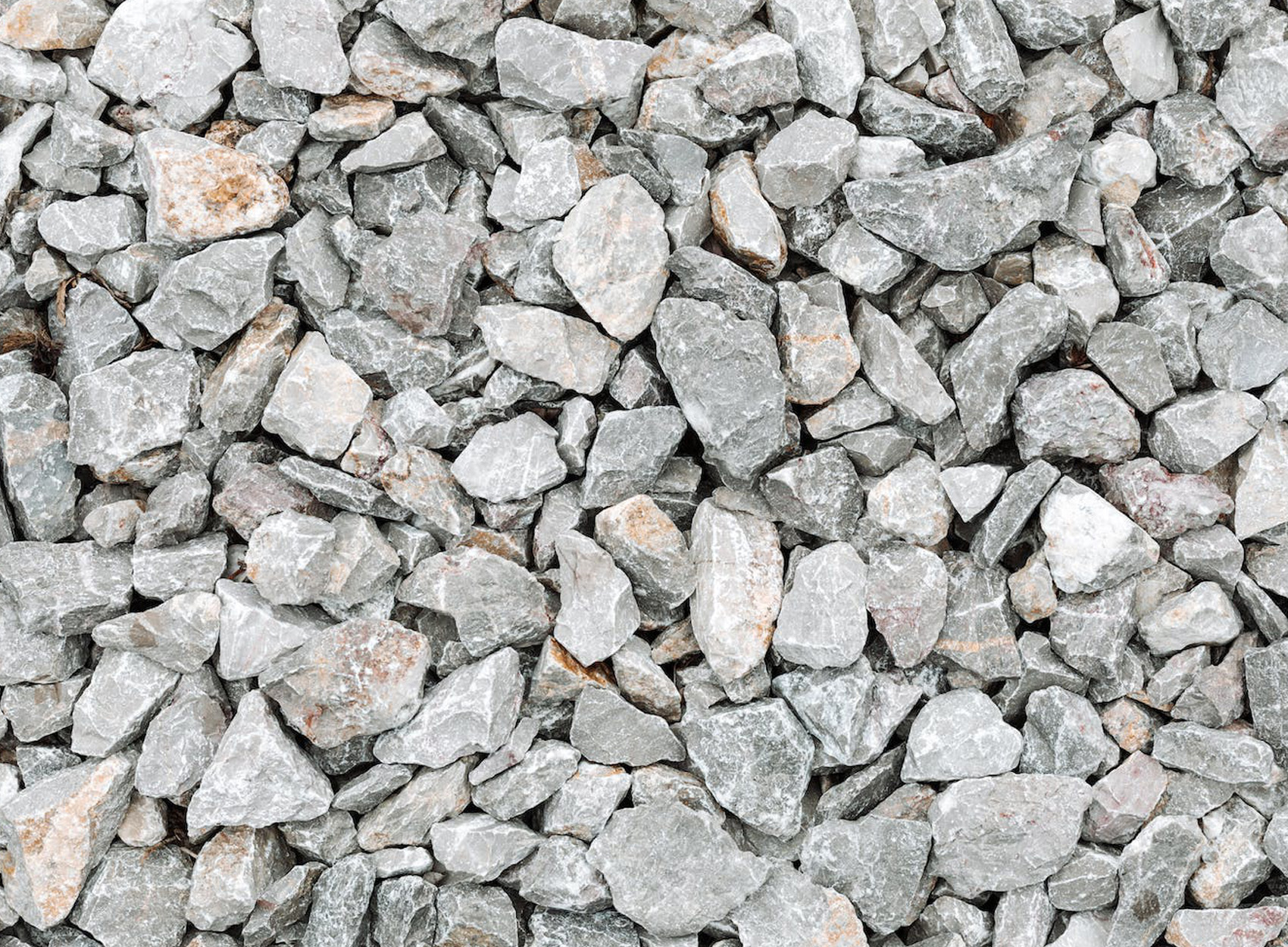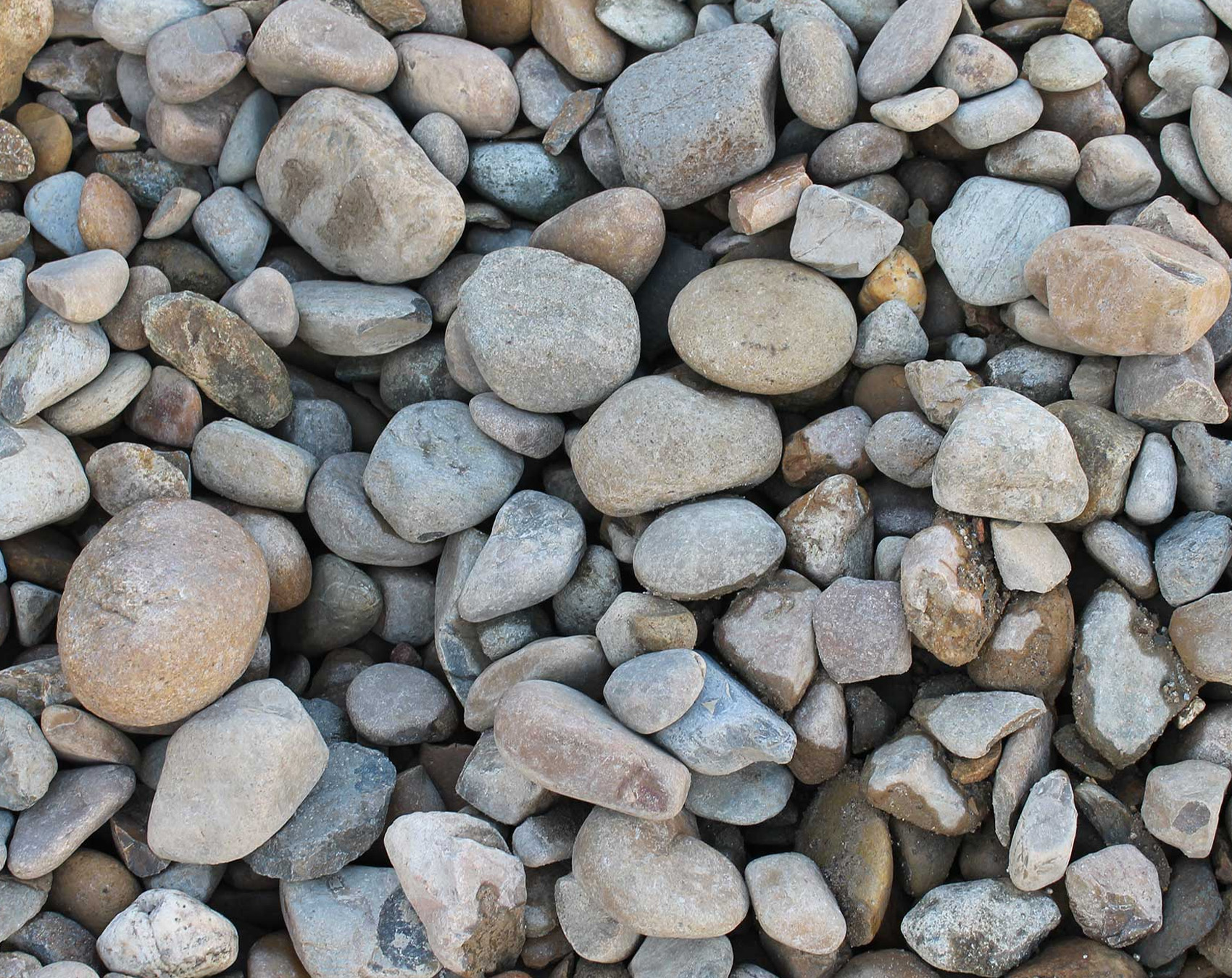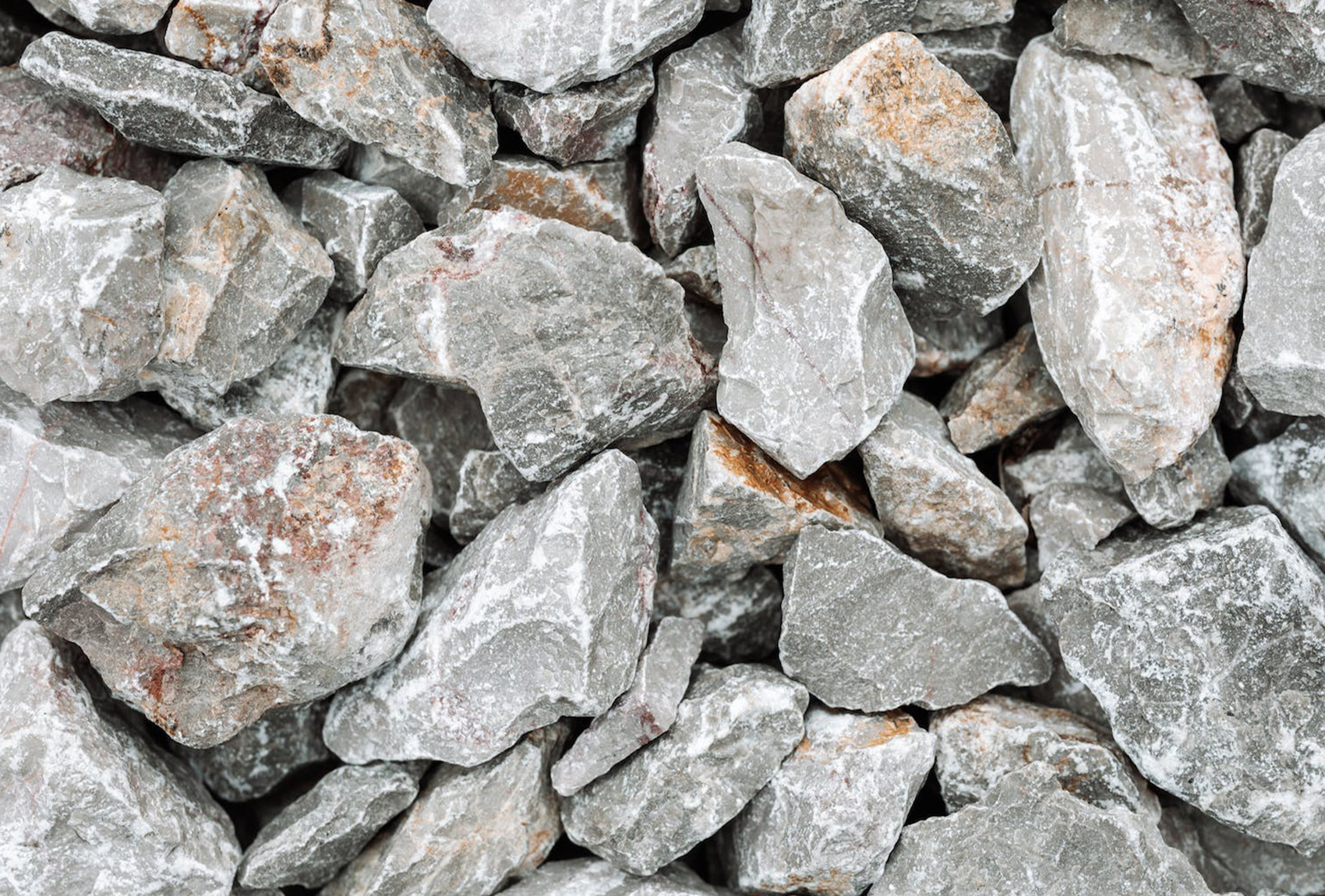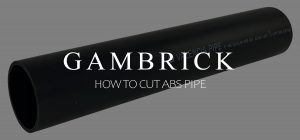What Gravel Is Best For Drainage?
The best gravel size for drainage is between 1/2 to 1 inch in diameter. #57 Crushed stone is best because it has an average size of 3/4 inch. Large gravel is best because it doesn’t compact as tightly as small stones. This leaves plenty of open space for water to run through the cracks and drain out. Small stones compact much tighter which seals the cracks. This can restrict the flow of water. If you have a drainage project, the best stone size to use is 3/4 inch trap rock. It ranges in size from 1/2 inch to 1 inch with an average size of 3/4 inch.
Gravel for drainage needs to be large enough for water to freely flow through the rocks after compaction. If the rocks are too small, they could prevent the flow of water which creates a runoff. But they also need to stop debris, like leaves, on the surface. If the stones are too large, leaves and other debris can get into the cracks where they can eventually build up and prevent the flow of water.
The best and most popular size gravel for drainage is 3/4 inch which is #57. But areas with very heavy water flow or without drainage pipes may need larger gravel. If the gravel is too small to handle heavy water-flow, the cracks between stones will fill up and you’ll get runoff.
Make sure to keep the rocks clean and free of leaves and other debris if you use large gravel.
What Gravel Is Best For Drainage Chart
The following chart shows the most common gravel sizes by grade or number along with their size and uses. In general, the larger the gravel the better it drains. But large gravel doesn’t compact as well which makes it harder to walk and drive on. It also has more space between the stones where debris and leaves can collect.
| Crushed Stone Grade or Number | Size | Drainage |
| #1 | 2″ to 4″ long | Great drainage for extreme amounts of water. Best used for filling in holes or large rock drainage ditches. |
| #2 | ½″ to 2-2/2″ wide | Drains large amounts of water. Less drainage than #1 but more than #3. Mostly used to build stone reservoirs. |
| #3 | ½″-2″ wide | One of the most common drainage gravel sizes. Great for below grade drainage trenches and footings. |
| #5 | 1″ or less | Good drainage that compacts well. Mostly used as a paver base. |
| #8 | ⅜″-½″ | Mostly used in concrete mixes and not for drainage. |
| #10 (Stone dust, rock, or gravel screenings) | ⅛″ or smaller | Used as a base material for paving stone and brick. Does not provide good drainage. |
| #57 | ¾″ average size | One of the most common gravel sizes used for drainage. Used for driveways, footings, paths, trenches, etc. |
| #67 | less than ¾″ | Used for driveways, backfill or around drainage pipe. Has OK drainage. #57 is a more common choice. |
It’s OK to layer gravel of different sizes. Larger gravel is typically used as a base layer with smaller gravel on top. The most common combination is #3 gravel as a base with #57 on the surface.
Use irregular jagged shaped gravel instead of smooth stones when possible. They don’t compact as tight which allows for better drainage.
The Best Gravel Size For Drainage On The Bottom Layer
Gravel for drainage is generally installed in multiple layers. The bottom layer typically has the largest stone because it’s better for drainage and looks aren’t a factor. Smaller, more attractive stones are usually spread on top because they look better, are easier to walk on and clean, and help collect debris like leaves.
The best stone for drainage at the bottom of a ditch is 3/4 inch drainage stone or trap rock. This stone is right in the middle between 1/2 inch to 1 inch gravel, is great for drainage but still small enough to catch debris. I prefer irregular jagged stone for a base layer rather than round stone because it doesn’t compact as tightly which makes it better for drainage.
Gravel is necessary for many landscape projects and not just beautiful rock gardens. Retaining walls and other features that require drainage make great use of large gravel to allow water to drain away faster than soil would. When you’re doing a DIY landscape project, it’s important to choose the right type of gravel. Here is an explanation of your options and their benefits.
The Best Gravel Size For Drainage On The Top Layer
A drainage ditch typically has multiple layers of gravel stacked atop one another. generally, the bottom layer has the biggest size gravel with a drainage pipe. Gravel layers on top are typically smaller, with the smallest gravel being the top layer. The top layer is usually spread very thin because it’s mainly for looks. But the rocks still need to be large enough to allow for drainage.
If you want to use really small gravel, like pea gravel, you need an outdoor drain cover or grate on the surface. Water has a hard time flowing through very small gravel, so if you use some, you need to install a drain for water to flow into.
Without a drain cover or grate, water on the surface will runoff when it hits gravel that’s too small instead of draining into the ditch.
Here are some options:
- Pink Quartz: This is a very popular top layer stone that’s around 1/2 inch in size. It has a light pinkish hue.
- Northern Granite River Rock: A smooth and more naturally colored small stone that works really well as a top layer. It’s typically around 1/2 inch on average.
- White Dolomite: A crushed white dolomite crystalline stone that’s around1/2 inch in size on average. It’s a great option for more modern landscapes.
When you use small gravel as a top layer, make sure it’s a thin layer. I usually spread no more than 1 inch deep. It’s primary purpose is looks but it’s also easier to walk on and keep clean with a rake or broom.
What Gravel Size Is Worst For Drainage?
For drainage projects, you don’t want to use any type of pea stone or really small gravel. Anything under a 1/2 inch average size is generally considered too small for drainage. Stone this small can be quite beautiful and great for other applications, but it’s too small to drain properly.
Small stones under 1/2 inch in average diameter are not considered a drainage stone. If you use them, water will typically overwhelm the rocks and run off.
If you plan on using small stone anyway, make sure to include surface drains and grates for the water to drain. Without a place for water to drain it will runoff and flood areas where you don’t want water collecting.
Do not use sand as a gravel bed. Sand is considered an aggregate and is used in many landscape projects. It’s a great material for a wide variety of projects but is terrible for drainage.
What Kind Of Gravel Is Best For A Drainage Ditch?
The best type of gravel for a drainage ditch is between 1/2 inch to 1 1/2 inch in diameter. Use #3 crushed stone or 3/4 inch trap rock. They can be purchased from almost all landscape suppliers and hardware stores. #3 crushed stone is between 0.5 and 2 inches in size with an irregular shape. This makes it a great choice for a drainage ditch with or without a pipe.
If you want a top layer of smaller crushed stones, use #57. It’1 1/2 inch to 1 inch in size with an average diameter of 3/4 inch. That’s large enough to allow good drainage but small enough to collect debris on the surface.
Spreading an inch or so of smaller stones on top of a drainage ditch makes the ditch easier to walk on and keep clean. But don;t use stones that are too small or they’ll fall into the cracks which can prevent the flow of water.
- #3 Crushed stone is the best gravel for a drainage ditch
- You can buy #3 crushed stone at hardware stores or landscape suppliers
- Use #3 crushes stone for both drainage ditches with or without a pipe
#3 crushed stone is a great choice for building a french drain. Here’s how to do it:
- Spread a few inches of gravel on the bottom of the ditch and compact
- Lay your perforated pipe on top of the gravel base, make sure it runs down hill
- Fill the ditch with gravel and compact
- Spread a thin layer of smaller gravel on top for looks
Is Crushed Gravel Good For Drainage?
Crushed gravel is an excellent excellent stone for drainage. But you have to get the right size and shape. Larger stones ranging from 1/2 inch to 2 inch generally work best for most drainage ditches. However you can use even bigger stones if the ground is muddy or there’s a heavy amount of water.
The best shape gravel to use is angular rather than round. When irregularly shaped jagged stones compact, there’s still lots of open space for water to flow. However, when round stones compact they get tight which can hamper drainage.
#3 and #57 crushed gravel are both excellent choices for most drainage ditches.
- Crushed gravel is a great choice for drainage
- #3 or #57 crushed stone works best for most drainage ditches
- Use #3 as a base layer with an inch or 2 of #57 on top
- Use an angular crushed gravel instead of smooth stones
- Gravel between 1/2 inch and 2 inches is the best choice for drainage
- 3/4 inch crushed gravel or trap rock is the best choice for most construction drainage projects like foundations, retaining walls and drainage ditches
A gravel that’s between 0.5 and 1.5 inches in diameter is the best choice for most drainage projects. You can go up to inches and above if there’s an extreme amount of water.
- Gravel that’s too small compacts tighter which can slow down drainage and create runoff
- Irregular jagged stone doesn’t compact as tightly as round stones
- Very large stones are harder to work with and can form an unstable, shifting surface, but they;re great as a base layer for large drainage ditches
- Layer your stones. The largest go on the bottom with smaller top layers
- The surface layer can use smaller stones, but no less than 1/2 inch
Is #57 Gravel Good For Drainage?
#57 crushed stone is a great choice for most drainage projects. It ranges in size from 0.5 inch to 1.5 inch with an average size of 0.75 inch in diameter. Use jagged, irregularly shaped stone rather than round. #57 gravel is large enough to allow drainage but small enough to walk or drive on. Unless you’re dealing with an extreme amount of water, #57 is usually the best choice. I use it for all my construction drainage projects like retaining walls, footings, driveways, foundations, drains, ditches, etc.
#57 is a drainage stone and not for landscaping. If you want to dress up the top layer of your project, spread an inch of better looking stone on top.
- #57 crushed stone provides great drainage for footings, driveways, retaining walls, walkways, French drains, etc.
- If you’re pouring a crushed gravel driveway, spread #3 crushed stone as a base layer, then pour #57 on top
- #3 crushed stone is bigger stone, which makes it better for in-ground drainage trenches, but #57 can be used as a substitute.
For a gravel driveway, pour a 5–6-inch deep layer of #3 gravel and compact it hard while spraying it lightly with water. Then, spread 2–3 inches of #57 gravel. Compact it hard while spraying it lightly with water. Using a larger stone on the bottom provides excellent drainage but forms a driveway surface that’s easy to walk and drive on.
- Use #57 gravel for small runoff drains and small to medium amounts of water.
- For larger drains, such as a french drain, use #3 crushed stone. It’s a little larger than #57 and provides great drainage for below ground applications.
- It’s OK to spread some #57 on top of a #3 base layer, but never use #3 on top of #57.
Is Pea Gravel Good For Drainage?
Pea gravel is very bad for drainage and should never be used in any sort of drain or ditch. Pea gravel is a very small round stone about 3/8 inch in diameter, which is the size of an average pea. Because the stones are rounded and very small, it compacts extremely tight, which is horrible for drainage. Once compacted, there’s almost no room for water to flow through. The gravel quickly becomes overwhelmed with water which causes runoff. A drainage trench, driveway, wall or footing where pea gravel is used will be prone to flooding and runoff.
- Pea gravel is very bad for drainage
- The stones are too small and round to provide adequate drainage
- Pea gravel compacts tightly which prevents water from draining through. This causes runoff and flooding
- Do not use pea gravel for drainage trenches or footings
- Do not use pea gravel as a top layer over larger gravel rock. It will fall into the spaces between larger stones which blocks water from draining through
Pea gravel has some uses as a surface level decorative gravel, but it’s not used for drainage.
If you need gravel for a drainage ditch or footing, choose angular gravel instead of round and a diameter of around 3/4 inch. #57 or #3 crushed stone is the best gravel size for most drainage projects.
Irregular, angular-shaped gravel is best for drainage because it won’t compact together. The space between stones allows water to drain through freely which promotes good drainage rather than slowing water down.
Do not use pea gravel as a top layer over a larger gravel base. It will fall into the spaces between the larger stones which prevents water from draining through.
Is Sand Good For Drainage?
No, sand is the worst aggregate you can use for drainage. The particles are too small and compact too tight. When sand is used in a drainage ditch with gravel, it acts as a mortar, sealing up the spaces between the gravel stones. It blocks the flow of water and causes runoff, wash-outs and flooding. If you need drainage, always use gravel instead of sand.
A layer of large to medium-sized angular 3/4″ gravel will allow water to flow through it and drain. Sand will compact so tightly it becomes like a solid and blocks water. If you use sand instead of gravel, your ditch will flood or be destroyed by washouts.
Sand and gravel used together is just as bad as using sand alone if the sand is on top of the gravel. It will pack into the spaces between gravel stones which prevents water from draining through.
If you use sand and gravel together, the sand must be used on the very bottom as a base layer. Then gravel can be spread on top and compacted.
- Gravel is much better at providing drainage than sand
- Sand is the worst aggregate you can use for drainage
- Sand compacts so tightly it acts as a solid which prevents water from draining through
- If you level an area with sand, gravel can be placed on top for drainage
- Sand should never be spread on top of drainage gravel. It will gum up the cracks between gravel stones which prevents drainage
If you use sand as a leveling base layer for a driveway, footing or drainage ditch, compact it down hard and add gravel on top. Do not pour any sand on top of the gravel. It will clog up the space between stones and prevent drainage.
Is River Rock Good For Drainage?
Yes, river rock is very good for drainage. It’s a big rounded stone that looks great and can drain large amounts of water. But it’s not a great choice for a pathway or driveway. The stones are too large and hard to drive or walk on. If you’re building a creek bed, swale or rock drainage ditch, river rock is a good choice.
River rock is rounded and doesn’t compact to form a solid base for walking or driving on. It’s best for drainage and/or decoration. Because it’s so large and great looking, river rock is one of the few stones that can be used on top of smaller gravel.
When building a rock drainage ditch, smaller 1/2 inch to 2 inch gravel is used as a base layer with river rock on top. This mimics the look of a natural dry creak bed but has the ability to drain large amounts of water.
- River rock provides great drainage for creek beds and rock drainage trenches
- Don’t use river rock on a surface that will be walked or driven on
- To prevent weeds from growing through river rock, pour a base layer of 3/4 inch drainage gravel first followed by river rocks
- River rock is heavy and rounded stone which allows a lot of water to drain through, but it’s easy for debris and leaves to collect in between the stones which can interfere with drainage. Make sure to keep them clean
Because river rock does not compact very well, weeds and plants can grow through if you don’t pour a gravel base or use felt.
River rock is a beautiful stone with great drainage capability. But it’s not a good surface stone or base layer.
What Size Stone Is Best For Drainage?
For most types of drainage projects, the best size stone is between 0.5 inch and 1.5 inches. I use #57 drainage gravel for footings, trenches, driveways paths, walls, etc. It has an average size of 0.75 inches which is good for light to medium amounts of water. If you’re dealing with larger amounts of water, embed a drainage pipe inside the gravel or use larger gravel.
#3 is between 0.50 and 2.0 inches in diameter. It’s better than #57 if you’re dealing with more water or building a drainage trench. When your drainage ditch is sub-grade, use #3, when it’s surface level, use #57.
#57 gravel is better for surface level gravel because it compacts tight enough to walk and drive on but still allows water to drain through. Larger gravel doesn’t compact as tight which makes it harder to walk and drive on.
- #3 Crushed Stone: Best for below grade drainage ditches like a french drain. It’s a good material for the base of a driveway or retaining wall footing.
- #57 Crushed Stone: Best for surface level drainage that requires good drainage and may be walked on. You can even use it on top of a #57 gravel base.
Use larger #3 crushed stone for more drainage and underground ditches. Use #57 crushed stone for smaller projects, surface level drainage or when using a perforated drainage pipe.
Always make sure to grade your trenches downhill so water flows away from your driveway, path, house, wall, etc.
Summary: What Gravel Is Best For Drainage?
The best gravel size for drainage is between 1/2 to 1 inch in diameter. #57 Crushed stone is best because it has an average size of 3/4 inch. Large gravel is best because it doesn’t compact as tightly as small stones. This leaves plenty of open space for water to run through the cracks and drain out. Small stones compact much tighter which seals the cracks. This can restrict the flow of water. If you have a drainage project, the best stone size to use is 3/4 inch trap rock. It ranges in size from 1/2 inch to 1 inch with an average size of 3/4 inch.
Gravel for drainage needs to be large enough for water to freely flow through the rocks after compaction. If the rocks are too small, they could prevent the flow of water which creates a runoff. But they also need to stop debris, like leaves, on the surface. If the stones are too large, leaves and other debris can get into the cracks where they can eventually build up and prevent the flow of water.
The best and most popular size gravel for drainage is 3/4 inch which is #57. But areas with very heavy water flow or without drainage pipes may need larger gravel. If the gravel is too small to handle heavy water-flow, the cracks between stones will fill up and you’ll get runoff.
Make sure to keep the rocks clean and free of leaves and other debris if you use large gravel.
If you have any questions or comments about what size gravel is best for your drainage project, email any time.

























